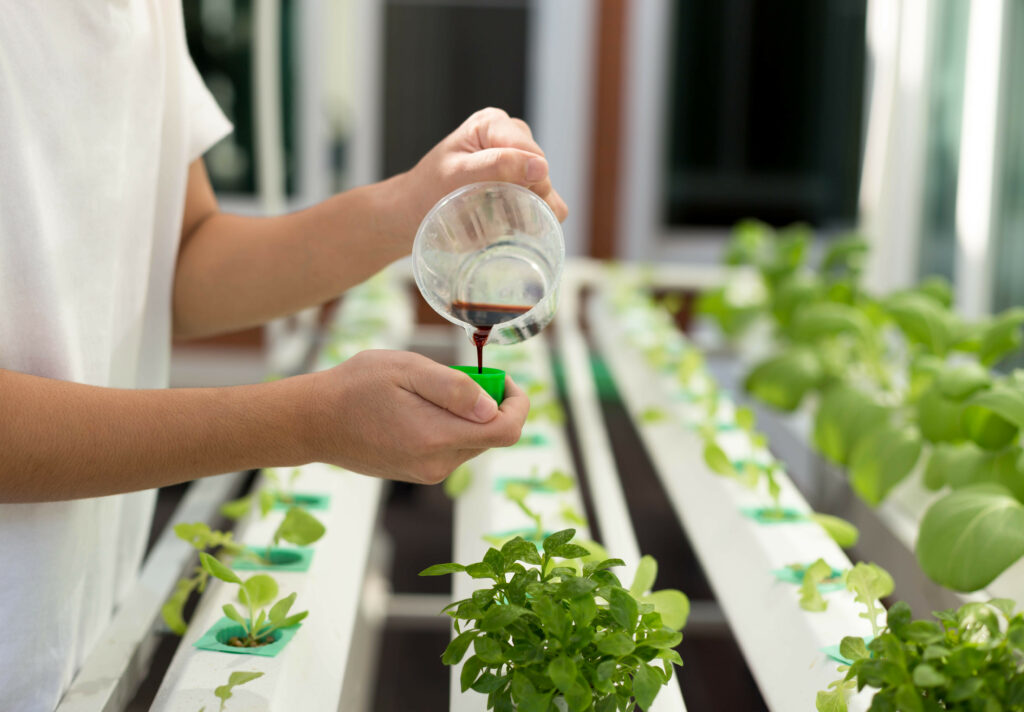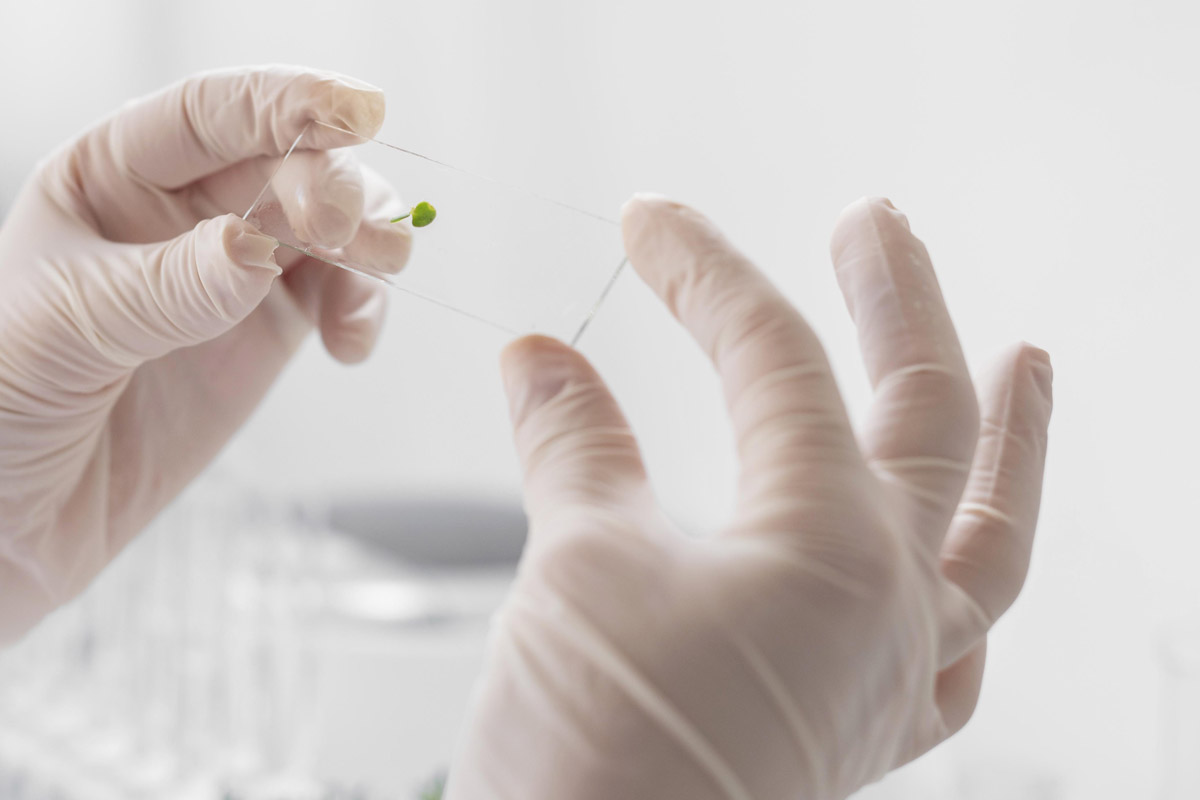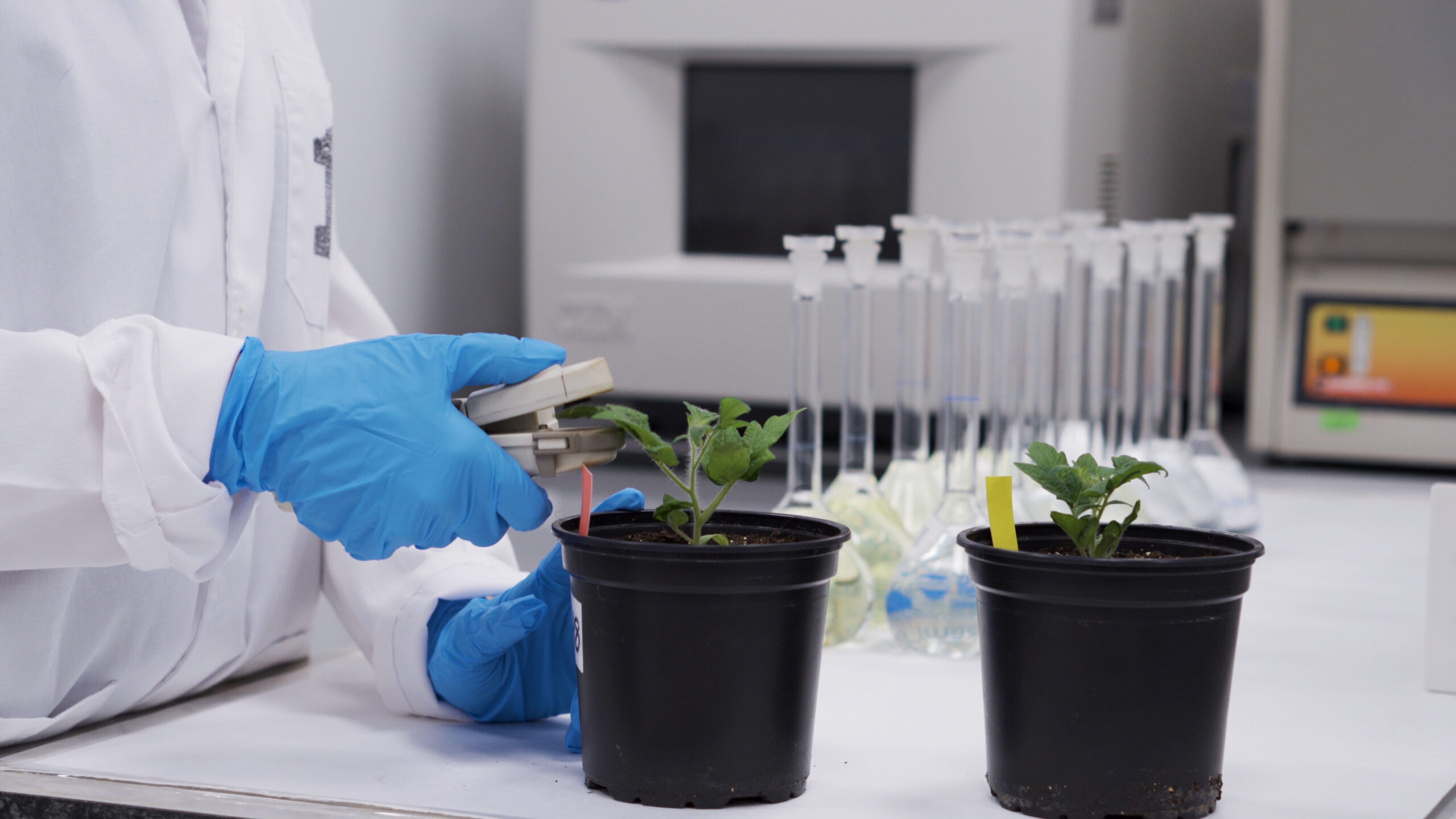Dadelos Agrosolutions biostimulants are highly effective solutions for enhancing plant growth and productivity. Our raw materials are derived from fermentation, which produces a variety of amino acids and active bio-compounds. These raw materials are then fortified with our exclusive technology, which enhances their efficacy and potency.

Dadelos Agrosolutions biostimulants assay result. Each peak represents a metabolite in the composition.
Our biostimulants are multi-compounds, containing a battery of amino acids and other active compounds that act synergistically to provide specific functions and increase the overall value of our products. Our products have been proven to enhance nutrient uptake, stress tolerance, and overall plant health, leading to improved yields and higher-quality crops. With Dadelos Agrosolutions´ biostimulants commodities, biostimulant formulators can achieve more sustainable and profitable products while promoting the health and well-being of the environment. We are proud to mention that we are a leading global supplier of commodities based on amino acids for plant biostimulants.
The Importance of Amino Acids in Plant Life and Potential Applications as Biostimulants
Proteins are composed of amino acids, which are characterized by a carboxyl group (-COOH), an amino group (-NH2), a hydrogen atom, and a unique side chain (R) for each amino acid. While approximately 500 amino acids are found in nature, only 20 are protein amino acids and are present in protein composition (Alvarado & Machado, 2021). Amino acids are joined by a peptide bond linking the carboxyl group of one amino acid to the amino group of the next (Salisbury & Ross., 1994).
Amino acids play a vital role in plant life as they are involved in essential reactions and contribute to plant growth and development (Hildebrandt et al., 2015).

8 Beneficial Functions of Amino Acids in Plants
Amino acids act by enhancing plant nutrition, serving as a source of energy, and playing a fundamental role during signaling processes, inducing tolerance and repair processes against abiotic stresses and being key structural components of plant tissues (Wang et al., 2017; Hildebrandt et al., 2015; Alvarado & Machado., 2021).
1. Amino acids are the building blocks of proteins.
Proteins are the main structural and functional component of cells; they are present in all biological processes and therefore have essential functions within the plant. Proteins are made up of one or more polypeptide chains, each of which is normally made up of hundreds of amino acids. The size and composition of each protein depend on the number and type of amino acid subunits (Salisbury & Ross, 2000; Augustin & de Victoria Muñoz, 2006; Cuevas-Velázquez & Covarrubias-Robles, 2011).
2. Precursors of metabolites that provide aroma and flavor to crops
Amino acids are precursors of a wide range of aromatic secondary metabolites with multiple biological functions (Tzin & Galili, 2010). Secondary, or specialized, metabolism serves a multitude of crucial functions for plant growth and development. Essential amino acids have also been shown to be precursors of volatile compounds; specifically, the amino acids leucine, isoleucine, valine, methionine, phenylalanine, tryptophan, and tyrosine are precursors of these volatile compounds capable of intensifying the perception of taste, sweetness or acidity (Maoz et al., 2022).
3. Regulators of primary metabolism
Amino acids are regulators of primary or central metabolism, which includes reactions and pathways vital for plant survival. Amino acids are used as a substrate to produce substances that will enable the plant to grow, develop and adapt. They are also precursors for the synthesis of enzymes that regulate metabolism. Amino acids have been shown to be the main nitrogen transporters in plants’ long-range transport systems (Okumoto et al., 2016). Within the amino acids, glutamic acid is essential for the proper functioning of the plant’s central metabolism, which includes nitrogen and carbon metabolism. The latter two have to be properly regulated because any dysfunction between them affects crop growth and development.
4. Precursors of hormone synthesis
Amino acids are also precursors of phytohormones; plant hormones are compounds produced by the plant that exercise their function in low concentrations, acting as regulators of growth and development. There are different types of hormones, among which we can highlight auxins, cytokinins, gibberellins, ethylene, etc. Some amino acids are precursors of hormones, such as tryptophan, which serves as a physiological precursor for auxin biosynthesis (Rojas et al., 2009; Saborio, 2002). Auxin enhances cell division and root expansion, improving lateral root development. Methionine is the metabolic precursor of ethylene which is responsible for the ripening of climacteric fruits. Phenylalanine is involved in the salicylic acid synthesis pathway, which protects the plant in case of abiotic stress.
5. Precursors of chlorophyll synthesis
Amino acids are able to stimulate chlorophyll synthesis; for example, glutamic acid is the precursor of chlorophyll, and this effect translates into a higher photosynthetic rate that allows the plant to grow and develop better (Serna-Rodríguez et al., 2011). This is why a lack of glutamic acid is associated with low chlorophyll levels and a yellow appearance of the leaves.
6. Stress protectors
To minimize the negative effects of abiotic stress, plants have developed different strategies, several of which are related to amino acid metabolism. In these situations, it has been found that some plants accumulate free amino acids (Batista-Silva et al., 2019). Amino acids serve for the production of new enzymes that neutralize toxic substances produced by stress and synthesize new substances and antioxidant molecules that limit the damage caused by environmental conditions (Figure 2). When plants are under stress, they are able to accumulate proline and other amino acids; these accumulated amino acids in plants perform different functions; they act as osmolytes, modulate the opening of stomata, regulate ion transport, and detoxify heavy metals (Rai, 2002). Proline is an amino acid that acts as an organic osmolyte and accumulates in plants in response to stress to protect cells. The presence of some amino acids activates the synthesis of glutathione (GSH), a potent antioxidant enzyme that contributes to the detoxification of reactive oxygen species (ROS) produced under abiotic stress conditions. The antioxidant capacity of Dadelos Agrosolutions raw materials neutralizes free radicals caused by stressful situations, ensuring optimal growth.
7. Chelating agents
Chelating agents are compounds that improve the availability of micronutrients in plant tissues (Souri & Hatamian, 2019). Amino acids act as chelators by enhancing nutrient uptake and translocation within the plant (Jacob et al., 2022). Specifically, the amino acids glycine and glutamate act as chelators within plants.
8. Essential for the reproductive system
Free amino acids are involved in the metabolism of flowers, stimulating cell division and energy production. They are essential components of flower nectar and play a role in the attractiveness of nectar to pollinators. Studies have shown that nectars enriched in amino acids attract pollinators. Amino acids such as proline and GABA have important roles in aspects of plant reproduction such as pollen development, pollination, and pollen tube guidance. Proline is the most abundant amino acid in nectar, and it has been shown that pollinators such as honeybees show a preference for nectars enriched in proline (Biancucci et al., 2015; Borghi & Fernie, 2017).
BIBLIOGRAPHY
Alcantara-Cortes, J. S., Acero Godoy, J., Alcántara Cortés, J. D., & Sánchez Mora, R. M. (2019). Main hormonal regulators and their interactions in plant growth. Nova, 17(32), 109-129.
Alvarado, Á. A. C., & Machado, I. D. L. C. E. (2021). Determinación del perfil de aminoácidos libres en órganos vegetativos de chile habanero (Capsicum chinense Jacq.) bajo distintas fuentes de nitrógeno y en frutos de diferente grado de desarrollo (Doctoral dissertation, Centro de Investigación Científica de Yucatán).
Augustin, O. M., & de Victoria Muñoz, E. M. (2006). Proteins and peptides in enteral nutrition. Nutricion hospitalaria, 21, 1-14.
Baqir, HA, Zeboon, NH y Al-behadili, AAJ (2019). El papel y la importancia de los aminoácidos dentro de las plantas: una revisión. Archivos de plantas , 19 (2), 1402-1410.
Batista‐Silva, W., Heinemann, B., Rugen, N., Nunes‐Nesi, A., Araújo, W. L., Braun, H. P., & Hildebrandt, T. M. (2019). The role of amino acid metabolism during abiotic stress release. Plant, cell & environment, 42(5), 1630-1644.
Biancucci, M., Mattioli, R., Forlani, G., Funck, D., Costantino, P., & Trovato, M. (2015). Role of proline and GABA in sexual reproduction of angiosperms. Frontiers in Plant Science, 6, 680.
Borghi, M., & Fernie, A. R. (2017). Floral metabolism of sugars and amino acids: implications for pollinators’ preferences and seed and fruit set. Plant Physiology, 175(4), 1510-1524.
Causin, HF (1996). El papel central de los aminoácidos en la utilización de nitrógeno y el crecimiento de las plantas. Revista de fisiología vegetal, 149 (3-4), 358-362.
Castillo Sánchez, E. J. (2022). Importancia de los aminoácidos en la agricultura bajo condiciones de estrés abiótico (Bachelor’s thesis, BABAHOYO: UTB, 2021).
Cuevas-Velázquez, C. L., & Covarrubias-Robles, A. A. (2011). Las proteínas desordenadas y su función: una nueva forma de ver la estructura de las proteínas y la respuesta de las plantas al estrés. TIP Revista Especializada en Ciencias Químico-Biológicas, 14(2), 97-105.
Du Jardin, P. (2015). Plant biostimulants: Definition, concept, main categories and regulation. Scientia horticulturae, 196, 3-14.
Forsum, O., Svennerstam, H., Ganeteg, U., & Näsholm, T. (2008). Capacities and constraints of amino acid utilization in Arabidopsis. New Phytologist, 179(4), 1058-1069.
Galili, G., Amir, R., & Fernie, A. R. (2016). The regulation of essential amino acid synthesis and accumulation in plants. Annual review of plant biology, 67, 153-178.
Ibrahim, M., & Al-Dabbagh,M. (2022). Amino Acids. 10.13140/RG.2.2.34897.61288.
Jacob, R. H., Afify, A. S., Shanab, S. M., & Shalaby, E. A. (2022). Chelated amino acids: biomass sources, preparation, properties, and biological activities. Biomass Conversion and Biorefinery, 1-15.
Manresa, R. (1968). La fertilización foliar con aminoácidos. Horticultura, 3.
Maoz, I., Lewinsohn, E., & Gonda, I. (2022). Amino acids metabolism as a source for aroma volatiles biosynthesis. Current Opinion in Plant Biology, 67, 102221.
Rai, V. K. (2002). Role of amino acids in plant responses to stresses. Biologia plantarum, 45(4), 481-487.
Okumoto, S., Funck, D., Trovato, M. y Forlani, G. (2016). Aminoácidos de la familia del glutamato: Funciones más allá del metabolismo primario. Fronteras en la ciencia de las plantas , 7 , 318.
Saborío, F. (2002). Bioestimulantes en fertilización foliar. Fertilización Foliar: Principios y Aplicaciones, 107-126.
Sajadi, S. A. A. (2010). Metal ion-binding properties of L-glutamic acid and L-aspartic acid, a comparative investigation. Natural Science, 2(02), 85.
Sharma, S. S., & Dietz, K. J. (2006). The significance of amino acids and amino acid-derived molecules in plant responses and adaptation to heavy metal stress. Journal of experimental botany, 57(4), 711-726.
Salisbury, F. B., Ross, C. W., González Velázquez, V., Palacios Martínez, R., & Philip, G. (1994). Fisiología vegetal.
Salisbury, F. B., & Ross, C. W. (2000). Fisiología de las plantas 2: Bioquímica vegetal. Madrid: Paraninfo Thomson Learning.
Serna-Rodríguez, J. R., Castro-Brindis, R., Colinas-León, M. T., Sahagún-Castellanos, J., & Rodríguez-Pérez, J. E. (2011). Foliar application of glutamic acid to tomato plants (Lycopersicon esculentum Mill.). Revista Chapingo. Serie horticultura, 17(1), 9-13.
Souri, M. K., & Hatamian, M. (2019). Aminochelates in plant nutrition: a review. Journal of Plant Nutrition, 42(1), 67-78.
-Trovato, M., Funck, D., Forlani, G., Okumoto, S., & Amir, R. (2021). Amino Acids in Plants: Regulation and Functions in Development and Stress Defense. Frontiers in Plant Science, 12.
Tzin, V., & Galili, G. (2010). New insights into the shikimate and aromatic amino acids biosynthesis pathways in plants. Molecular plant, 3(6), 956-972.
Wang, G., Xu, M., Wang, W., & Galili, G. (2017). Fortifying horticultural crops with essential amino acids: a review. International journal of molecular sciences, 18(6), 1306.
Weinbach, N. L., & Chesñevar, C. I. (2005). Un primer acercamiento al aprendizaje del código genético usando redes neuronales. In XI Congreso Argentino de Ciencias de la Computación.




